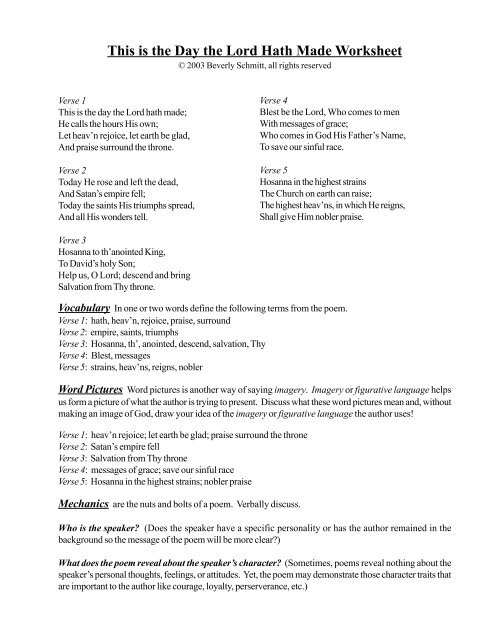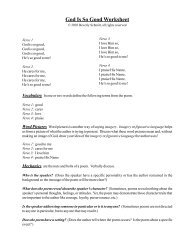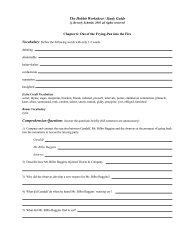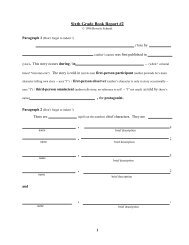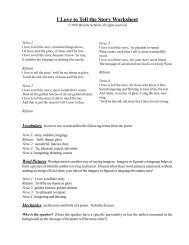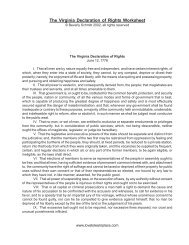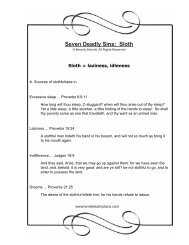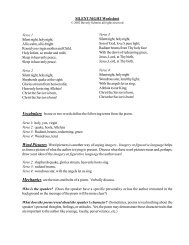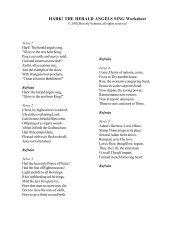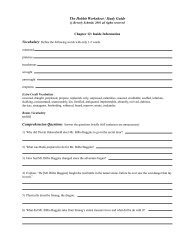This is the Day the Lord Hath Made Worksheet - Love to Learn Place
This is the Day the Lord Hath Made Worksheet - Love to Learn Place
This is the Day the Lord Hath Made Worksheet - Love to Learn Place
Create successful ePaper yourself
Turn your PDF publications into a flip-book with our unique Google optimized e-Paper software.
<strong>Th<strong>is</strong></strong> <strong>is</strong> <strong>the</strong> <strong>Day</strong> <strong>the</strong> <strong>Lord</strong> <strong>Hath</strong> <strong>Made</strong> <strong>Worksheet</strong><br />
© 2003 Beverly Schmitt, all rights reserved<br />
Verse 1<br />
<strong>Th<strong>is</strong></strong> <strong>is</strong> <strong>the</strong> day <strong>the</strong> <strong>Lord</strong> hath made;<br />
He calls <strong>the</strong> hours H<strong>is</strong> own;<br />
Let heav’n rejoice, let earth be glad,<br />
And pra<strong>is</strong>e surround <strong>the</strong> throne.<br />
Verse 2<br />
Today He rose and left <strong>the</strong> dead,<br />
And Satan’s empire fell;<br />
Today <strong>the</strong> saints H<strong>is</strong> triumphs spread,<br />
And all H<strong>is</strong> wonders tell.<br />
Verse 4<br />
Blest be <strong>the</strong> <strong>Lord</strong>, Who comes <strong>to</strong> men<br />
With messages of grace;<br />
Who comes in God H<strong>is</strong> Fa<strong>the</strong>r’s Name,<br />
To save our sinful race.<br />
Verse 5<br />
Hosanna in <strong>the</strong> highest strains<br />
The Church on earth can ra<strong>is</strong>e;<br />
The highest heav’ns, in which He reigns,<br />
Shall give Him nobler pra<strong>is</strong>e.<br />
Verse 3<br />
Hosanna <strong>to</strong> th’anointed King,<br />
To David’s holy Son;<br />
Help us, O <strong>Lord</strong>; descend and bring<br />
Salvation from Thy throne.<br />
Vocabulary In one or two words define <strong>the</strong> following terms from <strong>the</strong> poem.<br />
Verse 1: hath, heav’n, rejoice, pra<strong>is</strong>e, surround<br />
Verse 2: empire, saints, triumphs<br />
Verse 3: Hosanna, th’, anointed, descend, salvation, Thy<br />
Verse 4: Blest, messages<br />
Verse 5: strains, heav’ns, reigns, nobler<br />
Word Pictures Word pictures <strong>is</strong> ano<strong>the</strong>r way of saying imagery. Imagery or figurative language helps<br />
us form a picture of what <strong>the</strong> author <strong>is</strong> trying <strong>to</strong> present. D<strong>is</strong>cuss what <strong>the</strong>se word pictures mean and, without<br />
making an image of God, draw your idea of <strong>the</strong> imagery or figurative language <strong>the</strong> author uses!<br />
Verse 1: heav’n rejoice; let earth be glad; pra<strong>is</strong>e surround <strong>the</strong> throne<br />
Verse 2: Satan’s empire fell<br />
Verse 3: Salvation from Thy throne<br />
Verse 4: messages of grace; save our sinful race<br />
Verse 5: Hosanna in <strong>the</strong> highest strains; nobler pra<strong>is</strong>e<br />
Mechanics are <strong>the</strong> nuts and bolts of a poem. Verbally d<strong>is</strong>cuss.<br />
Who <strong>is</strong> <strong>the</strong> speaker? (Does <strong>the</strong> speaker have a specific personality or has <strong>the</strong> author remained in <strong>the</strong><br />
background so <strong>the</strong> message of <strong>the</strong> poem will be more clear?)<br />
What does <strong>the</strong> poem reveal about <strong>the</strong> speaker’s character? (Sometimes, poems reveal nothing about <strong>the</strong><br />
speaker’s personal thoughts, feelings, or attitudes. Yet, <strong>the</strong> poem may demonstrate those character traits that<br />
are important <strong>to</strong> <strong>the</strong> author like courage, loyalty, perserverance, etc.)
Is <strong>the</strong> speaker addressing someone in particular or <strong>is</strong> it <strong>to</strong> anyone? (Sometimes poems are not directed<br />
<strong>to</strong> anyone in particular, but <strong>to</strong> anyone that may read it.)<br />
Does <strong>the</strong> poem have a setting? (Does <strong>the</strong> author tell where <strong>the</strong> poem occurs? Is <strong>the</strong> poem about a specific<br />
event? )<br />
Is <strong>the</strong> poem about a particular event? (Is <strong>the</strong> event past or present? If it <strong>is</strong> about a past event, does <strong>the</strong><br />
remembrance of <strong>the</strong> event have a particular meaning <strong>to</strong> <strong>the</strong> speaker?)<br />
Is <strong>the</strong> <strong>the</strong>me of <strong>the</strong> poem stated directly or indirectly? (Some poems are straightforward and are meant<br />
<strong>to</strong> be taken literally. In songs, <strong>the</strong> <strong>the</strong>me may be presented in <strong>the</strong> refrain or in <strong>the</strong> last few lines. Sometimes <strong>the</strong><br />
<strong>the</strong>me <strong>is</strong> a little bit more difficult <strong>to</strong> d<strong>is</strong>cern as it <strong>is</strong> made with figurative language or symbols.)<br />
What point of view or perspective <strong>is</strong> <strong>the</strong> speaker? (What meaning do you think <strong>the</strong> poem has for <strong>the</strong><br />
author?)<br />
How did you respond <strong>to</strong> <strong>the</strong> poem when you read it <strong>the</strong> first time? (Did your thoughts and feelings<br />
change after you <strong>to</strong>ok time <strong>to</strong> study it?)<br />
Comprehension Questions Verbally d<strong>is</strong>cuss<br />
Verse 1: Who has made th<strong>is</strong> day? Who owns <strong>the</strong> hours? Who should rejoice? Who should be glad? What<br />
should surround <strong>the</strong> throne?<br />
Verse 2: Who rose? Whose empire fell? Who spreads H<strong>is</strong> triumphs? Where do <strong>the</strong>y spread it? What do<br />
<strong>the</strong>y tell of?<br />
Verse 3: Explain and d<strong>is</strong>cuss: “Hosanna <strong>to</strong> th’anointed King.” Did you notice <strong>the</strong> author used <strong>the</strong> term “th’ ”?<br />
Why do you think he did that? Who <strong>is</strong> David? Who <strong>is</strong> David’s Son? Who <strong>is</strong> <strong>the</strong> author asking help from?<br />
What <strong>is</strong> <strong>the</strong> author asking him <strong>to</strong> bring?<br />
Verse 4: Who <strong>is</strong> “blest”? Who does He come <strong>to</strong>? What <strong>is</strong> H<strong>is</strong> message? In Whose Name does He come?<br />
Remember, according <strong>to</strong> science, <strong>the</strong>re <strong>is</strong> only one race, homo sapiens. Explain and d<strong>is</strong>cuss: “To save our<br />
sinful race.”<br />
Verse 5: What does “Hosanna in <strong>the</strong> highest strains” mean? Why would th<strong>is</strong> be important? Who <strong>is</strong> <strong>to</strong> ra<strong>is</strong>e<br />
“Hosanna in <strong>the</strong> highest strains”? Who reigns in <strong>the</strong> “highest heav’ns”? Did you notice <strong>the</strong> term “heav’ns”?<br />
Why do you think <strong>the</strong> author used th<strong>is</strong> term?<br />
Did th<strong>is</strong> message become more real <strong>to</strong> you after reading th<strong>is</strong> poem? Why?<br />
After reading th<strong>is</strong> poem, what character traits did you think of? What does <strong>the</strong> Bible have <strong>to</strong> say about <strong>the</strong>se<br />
character traits?<br />
© 2003 Beverly Schmitt, all rights reserved
What Does <strong>the</strong> Bible Say?<br />
Find Scripture proofs for each of <strong>the</strong> assertions or statements made for each of <strong>the</strong> five verses.<br />
D<strong>is</strong>cuss th<strong>is</strong> poem in light of <strong>the</strong> ...<br />
Cultural Mandate (what God said <strong>to</strong> Adam and Eve) ... And God blessed <strong>the</strong>m, saying, Be fruitful, and<br />
multiply, and fill <strong>the</strong> waters in <strong>the</strong> seas, and let fowl multiply in <strong>the</strong> earth. (Genes<strong>is</strong> 1:28)<br />
Dominion Mandate (what God said <strong>to</strong> Noah after <strong>the</strong> Flood) ... And God blessed Noah and h<strong>is</strong> sons, and<br />
said un<strong>to</strong> <strong>the</strong>m, Be fruitful, and multiply, and replen<strong>is</strong>h <strong>the</strong> earth. (Genes<strong>is</strong> 9:1)<br />
Great Comm<strong>is</strong>sion (Jesus' command that reaffirmed <strong>the</strong> Cultural and Dominion Mandates) ... And Jesus<br />
came and spake un<strong>to</strong> <strong>the</strong>m, saying, All power <strong>is</strong> given un<strong>to</strong> Me in heaven and in earth. Go ye <strong>the</strong>refore, and<br />
teach all nations, baptizing <strong>the</strong>m in <strong>the</strong> name of <strong>the</strong> Fa<strong>the</strong>r, and of <strong>the</strong> Son, and of <strong>the</strong> Holy Ghost: Teaching<br />
<strong>the</strong>m <strong>to</strong> observe all things whatsoever I have commanded you: and, lo, I am with you alway, even un<strong>to</strong> <strong>the</strong> end<br />
of <strong>the</strong> world. Amen. (Mat<strong>the</strong>w 18:18-20)<br />
The Author/Poet<br />
Based on what you have studied about th<strong>is</strong> poem so far, would you guess that <strong>the</strong> author was a Chr<strong>is</strong>tian or<br />
a human<strong>is</strong>t? How did you arrive at your dec<strong>is</strong>ion?<br />
The name of <strong>the</strong> author for th<strong>is</strong> poem or lyric <strong>is</strong> Isaac Watts (1674-1748). He was born 17 July 1674, in<br />
Southamp<strong>to</strong>n, England, and died 25 November 1748, in S<strong>to</strong>ke Newing<strong>to</strong>n, England. He <strong>is</strong> buried at Bunhill<br />
Fields Cemetery, London, England. Watt’s had an interesting fa<strong>the</strong>r who was impr<strong>is</strong>oned two times for h<strong>is</strong><br />
religious views. Mr. Watts studied Greek and Latin but declined an offer for a standard university education<br />
preferring <strong>to</strong> attend <strong>the</strong> Nonconform<strong>is</strong>t Academy at S<strong>to</strong>ke Newing<strong>to</strong>n in 1690. When Mr. Watts was 20-22<br />
he stayed at home and wrote <strong>the</strong> majority of <strong>the</strong> hymns for Hymns and Spiritual Songs that were publ<strong>is</strong>hed in<br />
1707-1709. For six years he was <strong>the</strong> tu<strong>to</strong>r Mr. John Har<strong>to</strong>pp’s son. Mr. Watts was ordained in 1702.<br />
"Give 'em Watts, boys, give 'em Watts!"<br />
Interestingly, Isaac Watts <strong>is</strong> intimately connected with <strong>the</strong> American War of Independence. In an attack upon<br />
Springfield when <strong>the</strong> patriots' wadding gave out, Rev. James Caldwell (of Huguenot descent) ran in<strong>to</strong> a<br />
Presbyterian church returning with h<strong>is</strong> arms and pockets crammed full with Watts' Psalms and Hymns saying,<br />
"Now, boys, give <strong>the</strong>m Watts!" The Brit<strong>is</strong>h offered large rewards for <strong>the</strong> capture of Rev. Caldwell, but <strong>to</strong> no<br />
avail. Therefore, <strong>the</strong> Brit<strong>is</strong>h burned h<strong>is</strong> church, shot h<strong>is</strong> wife while she was in <strong>the</strong> midst of <strong>the</strong>ir nine children,<br />
dragged her body in<strong>to</strong> <strong>the</strong> street, and burned h<strong>is</strong> home and out buildings.<br />
Geography<br />
Locate Southamp<strong>to</strong>n, England, and Lond on a globe, map and atlas.<br />
Challenge Locate S<strong>to</strong>ke Newing<strong>to</strong>n (England) on a map or in an atlas.<br />
Compare/contrast England’s wea<strong>the</strong>r with your own for one week.<br />
Make an Engl<strong>is</strong>h meal for your family.<br />
© 2003 Beverly Schmitt, all rights reserved
Activities<br />
1) Make your own book! Without making an image of Chr<strong>is</strong>t, draw pictures repesenting each verse. (Note:<br />
that will be five different illustrations). With construction paper and o<strong>the</strong>r items readily available at home, make<br />
a title page with <strong>the</strong> name of <strong>the</strong> song and <strong>the</strong> author’s name which will be your book’s cover. You may want<br />
<strong>to</strong> illustrate your cover and include th<strong>is</strong> poem in your book.<br />
2) Make your own play! Re-enact with your siblings or friends <strong>the</strong> message d<strong>is</strong>cussed in th<strong>is</strong> poem. Keep it<br />
lively, simple, and short. You may want <strong>to</strong> end your play with singing a rousing chorus of th<strong>is</strong> poem or reading<br />
Scripture verses. Videotape your creation.<br />
3) Radio Drama! With a handheld tape recorder, create your own radio show dramatizing <strong>the</strong> message of th<strong>is</strong><br />
poem.<br />
4) Be a Reporter! Ei<strong>the</strong>r with your family camcorder or with a handheld tape recorder, “interview” various<br />
individuals connected with th<strong>is</strong> poem (e.g., WWI and WWII soldiers, doc<strong>to</strong>rs, dent<strong>is</strong>ts, sinners, repentant<br />
sinner, past/present heads of state, etc.). In order <strong>to</strong> have <strong>the</strong> fast paced style of a reporter, watch and/or l<strong>is</strong>ten<br />
<strong>to</strong> <strong>the</strong> news with your parents’ perm<strong>is</strong>sion. Keep <strong>the</strong> interviews lively, quick, and <strong>to</strong> <strong>the</strong> point.<br />
Remain objective! Being objective means just reporting <strong>the</strong> facts and not giving your opinion of <strong>the</strong> situation.<br />
5) What <strong>is</strong> one of <strong>the</strong> things you most enjoy? Is it literature? math? science? sports? cooking? Take that area<br />
of interest and relate that <strong>to</strong> th<strong>is</strong> poem. If you enjoy dance, for example, develop a dance routine that physically<br />
expresses <strong>the</strong> sentiments of th<strong>is</strong> poem. If you enjoy shop, create something out of wood that helps <strong>to</strong> clarify<br />
th<strong>is</strong> poem. Do you enjoy creating s<strong>to</strong>ries? Write a s<strong>to</strong>ry based on any time period you desire that expresses<br />
<strong>the</strong> sentiments of th<strong>is</strong> poem. Do you enjoy creating things in <strong>the</strong> kitchen? Make an ancient meal from th<strong>is</strong> time<br />
or develop your own meal that symbolizes <strong>the</strong> many different points th<strong>is</strong> poem makes.<br />
6) Poster. Create a poster illustrating <strong>the</strong> <strong>the</strong> author’s view of <strong>the</strong> impact of <strong>Th<strong>is</strong></strong> <strong>is</strong> <strong>the</strong> <strong>Day</strong> <strong>the</strong> <strong>Lord</strong> <strong>Hath</strong><br />
<strong>Made</strong>.<br />
7) Scavenger Hunt. Go <strong>to</strong> <strong>the</strong> library <strong>to</strong> learn what you can about Isaac Watts (1674-1748) and share it with<br />
your family. If possible, d<strong>is</strong>cover <strong>the</strong> s<strong>to</strong>ry behind th<strong>is</strong> poem.<br />
© 2003 Beverly Schmitt, all rights reserved


